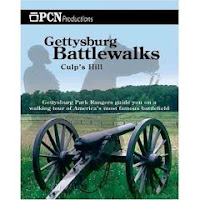
Gettysburg and Stories of Valor: Civil War Minutes Volume 3, Parts 1 & 2, writers: Michael Kraus, David Neville, director Michael Bussler, Inecom Entertainment Company, 90 minutes, 2004.
Inecom Entertainment Company is among the best small, independent producers of history documentaries. In terms of direction, content, writing, and production, I would pick an Inecom product over all others, including the History Channel. This pair of dvds is full of informative, but unpadded, and interesting, but unexaggerated, stories. The writers know the difference between trivia and obscure information. Trivia is humorous and superficial; obscure information is insightful and illustrates a larger truth. Part 1 of the set offers 14 topics on Gettysburg and part 2 sets forth 16 stories of the Civil War. Biographies and material culture, behavior and events are dual themes throughout Volume 3.
Interested in Civil War era medicine? On disk 2, there are short features about caring for the wounded, bullet wounds, and amputees. Looking for background on generals? On both disks there are stories of Winfield S. Hancock, Lewis Aristead, Alexander Hays and Felix Zollicoffer.
Haven't heard from Civil War era civilians recently? Meet John Burns of Gettysburg, and the men, women and children of Pittsburgh's Allegheny Arsenal who died on the afternoon of September 17, 1862. Take a look at one of the farmsteads that became a burial site for hundreds of Confederate dead at Gettysburg, the Forney farm. Explore Gettysburg's historic photographs that are faked. Walk through both the Evergreen and the National Cemteries on Cemetery Hill, Gettysburg. You'll find Confederates buried in the National Cemetery and the actual location of the podium for the Gettysburg Address in the Evergreen Cemetery.
The writers and director tell the stories of the men who carried the weapons by focusing on their material culture . Examine the path of shrapnel through a CSA major's coat sleeve. Carry a drum across the Emmitsburg Road, lose it and have it returned 20 years later. Go through the haverack and knapsack of a soldier. Cross the Dead Line at Andersonville; live in POW camps in the North.
Thankfully, reenactors are not in every shot; they are limited in their appearance to closeups as they handle their guns, bone saws, haversacks, and drums. Don't get me wrong; I am a reenactor and appreciate the 'living history aspect' of the hobby. But to show reenactors running through woods, up hills and across streams, ad nausem like the History Channel or MediaMagic frequently do, usually covers bad writing and unsupported generalizations.
The writers and directors show the actual implements of war as they are preserved in private and public collections throughout the country. The credits that run at the end of each disk will answer the question you will probably ask several times during your viewing of Civil War Minutes; "Where did they find that?" Civil War Minutes, Volume 3, Gettysburg and Stories of Valor, is recommended for all ages and all levels of interest in the Civil War.
Inecom Entertainment Company is among the best small, independent producers of history documentaries. In terms of direction, content, writing, and production, I would pick an Inecom product over all others, including the History Channel. This pair of dvds is full of informative, but unpadded, and interesting, but unexaggerated, stories. The writers know the difference between trivia and obscure information. Trivia is humorous and superficial; obscure information is insightful and illustrates a larger truth. Part 1 of the set offers 14 topics on Gettysburg and part 2 sets forth 16 stories of the Civil War. Biographies and material culture, behavior and events are dual themes throughout Volume 3.
Interested in Civil War era medicine? On disk 2, there are short features about caring for the wounded, bullet wounds, and amputees. Looking for background on generals? On both disks there are stories of Winfield S. Hancock, Lewis Aristead, Alexander Hays and Felix Zollicoffer.
Haven't heard from Civil War era civilians recently? Meet John Burns of Gettysburg, and the men, women and children of Pittsburgh's Allegheny Arsenal who died on the afternoon of September 17, 1862. Take a look at one of the farmsteads that became a burial site for hundreds of Confederate dead at Gettysburg, the Forney farm. Explore Gettysburg's historic photographs that are faked. Walk through both the Evergreen and the National Cemteries on Cemetery Hill, Gettysburg. You'll find Confederates buried in the National Cemetery and the actual location of the podium for the Gettysburg Address in the Evergreen Cemetery.
The writers and director tell the stories of the men who carried the weapons by focusing on their material culture . Examine the path of shrapnel through a CSA major's coat sleeve. Carry a drum across the Emmitsburg Road, lose it and have it returned 20 years later. Go through the haverack and knapsack of a soldier. Cross the Dead Line at Andersonville; live in POW camps in the North.
Thankfully, reenactors are not in every shot; they are limited in their appearance to closeups as they handle their guns, bone saws, haversacks, and drums. Don't get me wrong; I am a reenactor and appreciate the 'living history aspect' of the hobby. But to show reenactors running through woods, up hills and across streams, ad nausem like the History Channel or MediaMagic frequently do, usually covers bad writing and unsupported generalizations.
The writers and directors show the actual implements of war as they are preserved in private and public collections throughout the country. The credits that run at the end of each disk will answer the question you will probably ask several times during your viewing of Civil War Minutes; "Where did they find that?" Civil War Minutes, Volume 3, Gettysburg and Stories of Valor, is recommended for all ages and all levels of interest in the Civil War.










